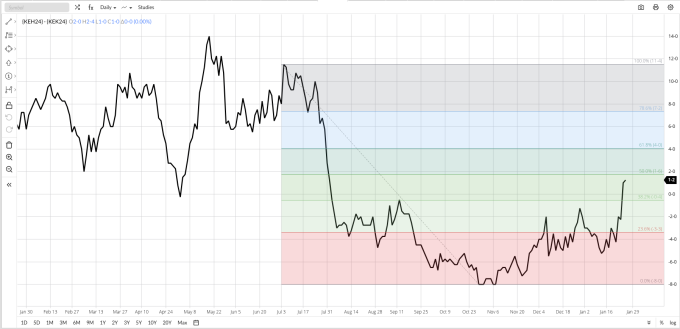- Thursday saw the March-May Kansas City (HRW) wheat futures spread close at an inverse/backwardation of 1.0 cent.
- As I've said in the past, when it comes to a storable commodity, an inverse/backwardation is always bullish.
- However, there is also something I call the Vodka Vacuity that says there are no Absoluts in markets, including an inverse always being fundamentally bullish.
Wheat and vodka. The latter can be made of the former, or anything that ferments. Both have ties to Russia and Eastern Europe in general. Both can make you regret getting involved with them. If you go to a liquor store you can find vodka in a number of fancy iterations, all trying to hide the fact it is still vodka. As Chef Alton Brown once said, “Vodka is just gin that someone was too lazy to finish”. Wheat comes in a number of classifications as well, but no matter what it’s called it is still wheat.

Why the focus on these two kindred spirits[i] this fine Friday? Because of Thursday’s close in Kansas City (HRW) wheat when we saw March finish at $6.37 and May settle at $6.36. Take a close look at those numbers and you’ll see it. That’s right, the nearby Kansas City wheat futures spread closed at an inverse. Now, think back to what I say about inverses: In a storable commodity, an inverse (backwardation) is ALWAYS (emphasis added for effect) bullish. I have countless stories about this, with my favorite being a meeting with the president of a company I worked for at the time.
He was an economist by trade and was convinced I was incorrect about how to read futures markets. “If the deferred contract is higher priced than the nearby”, he said, “then the market is bullish because it is willing to pay more later”. (In other words, the standard line from any economist.) I responded with my usual charm, telling the president of the company, “No, you are wrong. If the deferred contract is higher priced it means the market is willing to pay you less now, which is bearish.” I didn’t get fired. At least not that day.
The flip side of that argument is if the nearby contract is higher priced than the deferred, the market is telling you it needs supplies now, which is bullish. It doesn’t matter how much of an inverse/backwardation exists either. Another saying I like to use is a paraphrase of Dr. Seuss’ Horton the Elephant (of Horton Hears a Who), “An inverse is an inverse, no matter how small”. To which I tend to add, “And inverses are ALWAYS bullish.”
Putting it that way, though, I break one of my other thoughts on market analysis, something I like to call the Vodka Vacuity[ii]. This tells us that in markets, there are no Absoluts. Meaning my statement that inverses in storable commodities are ALWAYS bullish is wrong. In this case, they are USUALLY bullish, say roughly 99% of the time.
What makes this time different in HRW wheat? First and foremost, national average basis remains a train wreck. Thursday evening’s calculation (national cash index (IHY00) minus futures) came in at 54.75 cents under March Kansas City futures (KEH24) as compared to the previous 5-year low weekly close for this week of 31.25 cents under March. In other words, national average basis was running roughly 23.5 cents weaker than the its weakest reading (the past 5 years). That isn’t bullish either. A friend of mine, Tregg Cronin, used to present on the subject of Grains’ Golden Rule: First basis, then futures spreads, then futures. If basis is historically weak, then how much can we trust a move by the nearby futures spread into an inverse/backwardation?
Another indicator could be our latest read on export demand for US HRW. As of Thursday, January 18 the US reportedly had total sales of 106 mb, with total shipments of 33 mb and unshipped sales reported at 73 mb. This was down 34% from the reported 161 mb the same week the previous marketing year. Before we get too carried away with the argument, “Yeah but, last year’s export demand must’ve been HUGE!” No. No it wasn’t.
Reported shipments of US HRW wheat for 2022-2023 were 179 mb, down 32% from 2021-2022’s report shipments of 263.5 mb. Theoretically, the US is on pace to ship 55 mb this marketing year. That’s it, 55 mb. Putting the numbers and averages aside, I think the US will move more HRW than 55 mb, but it isn’t going to be market making. And before I forget: Yes, I’ve heard the hue and cry that China is in the market buying US HRW wheat. Another case of our great trade war foe stepping into save a US market. Those making that claim need to read Sun Tzu’s the Art of War.
What drove the March-May spread to an inverse/backwardation then, if not commercial buying? The more logical bet is noncommercial short-covering. Recall the previous Friday’s Commitments of Traders report (legacy, futures only) showed funds held a net-short futures position in Kansas City wheat of 28,047 contracts. Like much of the rest of the Grains sector, this was the one bullish factor I talked about in a recent piece for . If funds started covering their net-short futures position, and the March issue rallied as much as 23.25 cents from the previous Tuesday’s close through this past Tuesday’s high, then we can assume some short covering was taking place[iii]. Additionally, March KC extended its rally another 16.25 cents through Friday morning’s high indicating follow-through activity from Thursday’s rally.
All while basis remained weak, which would presumably kick the legs out from under the noncommercial-led rally at some point[iv].
And that is why wheat brought vodka to mind this week.
[i] There is actually a third we can add to this grouping: The famed Widow Maker itself, natural gas. My son writes trading algorithms and in his analysis one market in particular kept triggering trades alongside natural gas. According to his work, the two markets had an r-squared of 74%, a solid correlation. The market in question? Wheat, naturally. And in his words, Kansas City HRW specifically. All these decades of analyzing markets have taught me both natural gas and wheat are crazy, but I never made the connection. As the old saying goes, you can learn something new every day.
[ii] By definition, vacuity means “The quality of fact of being devoid of something specified”.
[iii] We’ll see the next round of CFTC reports Friday afternoon, for positions as of this past Tuesday.
[iv] As of this writing on Friday, January 26, March Kansas City wheat had dropped as much as 17.75 cents.
More Grain News from
- Corn Bulls Getting Out into the Weekend
- Red Friday has Soybeans Net Lower for Week’s Move
- Wheat Futures Dropping into Friday
- Soybean Prices Drop Double Digits
On the date of publication, Darin Newsom did not have (either directly or indirectly) positions in any of the securities mentioned in this article. All information and data in this article is solely for informational purposes. For more information please view the Disclosure Policy here.
Disclaimer: The copyright of this article belongs to the original author. Reposting this article is solely for the purpose of information dissemination and does not constitute any investment advice. If there is any infringement, please contact us immediately. We will make corrections or deletions as necessary. Thank you.







